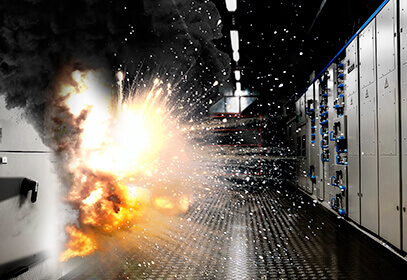 What is an arc flash? An arc flash, also known as a flashover, is an electrical explosion or discharge caused by a connection through the air to the ground or another phase of an electrical system. An example is when a wire comes in contact with an earthed system. The temperature at the source can reach 20,000 degrees Celsius, which is approximately four times the surface heat of the sun.
What is an arc flash? An arc flash, also known as a flashover, is an electrical explosion or discharge caused by a connection through the air to the ground or another phase of an electrical system. An example is when a wire comes in contact with an earthed system. The temperature at the source can reach 20,000 degrees Celsius, which is approximately four times the surface heat of the sun.
What Causes Arc Flash
Unintentional contact of an energized conductor (such as a busbar or wire) with another conductor or an earthed surface can cause an arc flash. An incident can also be caused by equipment failure.
Electrical Flashover
While many believe that arc flash is more common when working at high voltage, there is evidence to suggest that low voltage could be just as dangerous. Studies have shown that the severity of hazards is on average higher at low voltage than at high voltage.
The risk of causing harm depends on the current flowing in an arc and how long it is sustained. It also depends on the length of the gaps between conductive parts. These gaps are then bridged by the electrodes, confinement around the arc, the chemical compositions of conductors and materials around the arc, and the distance the worker is from the arc.
Common causes of arc flash are:
- Equipment failure
- Un-insulated tools and metal parts can be dropped
- Use of incorrectly-specified instruments
- Live work on equipment that is damaged, such as cables
- Exposed live parts and loose connections
- Training and awareness are lacking
How to Avoid Arc Flash
It is difficult to eliminate arc flash hazards completely, so it is important that you take steps to minimize the risk. Use arc guards provided by Becker Mining
Arc-Flash-Law-Requirement Booklets
Management of Health and Safety at Work Regulations 1999 imposes an obligation on the employer to assess the risk in the workplace and determine the effectiveness of any precautions taken. This should include arc flash hazards for electrical work.
Although the likelihood of an electrical arc happening is low, it is possible for severe consequences. To reduce the danger and the likelihood that it will occur, control measures can be taken. For example, you can:
- De-energize electrical equipment
- Wear appropriate Personal Protective Equipment (PPE).
- Maintain a safe distance
- Reducing the energy consumption from an incident
- Perform a risk assessment
- Training workers on-site to manage risks and interrupt faults
Arc flash hazard management is a great way to prevent arc faults. To reduce risks, use principles of prevention. Proper protection can reduce the chance of injury. For future workers, gather information to help them assess changes in the environment and equipment.
An electrical safety professional is one of the best ways you can reduce the risk of arc flash. You can also train if you have workers on the job and want to manage hazards yourself.
Why Would Anyone Need Arc Flash Training?
Arc flash can cause serious injury and death, and human error is a major factor in this. Effective training is crucial to minimize the risk. Both high and low-voltage incidents can be deadly for electrical personnel. This includes staff who test and maintain electrical equipment, such as electricians and electrical engineers.
Mechanics
Qualified people should be able to control fault currents using the appropriate devices, reduce arcing times, and calculate safe limits for arc flash. You will be able to recognize when you might be exposed and the level of danger, as well as know what legislation is in place.
Contact Us
At Becker Mining, we understand the importance of guaranteeing your safety in and around mines. We are always at the forefront of technology, striving to provide equipment that is safe and reliable. For more information, call Becker Mining, one of the top-quality manufacturers in the industry.